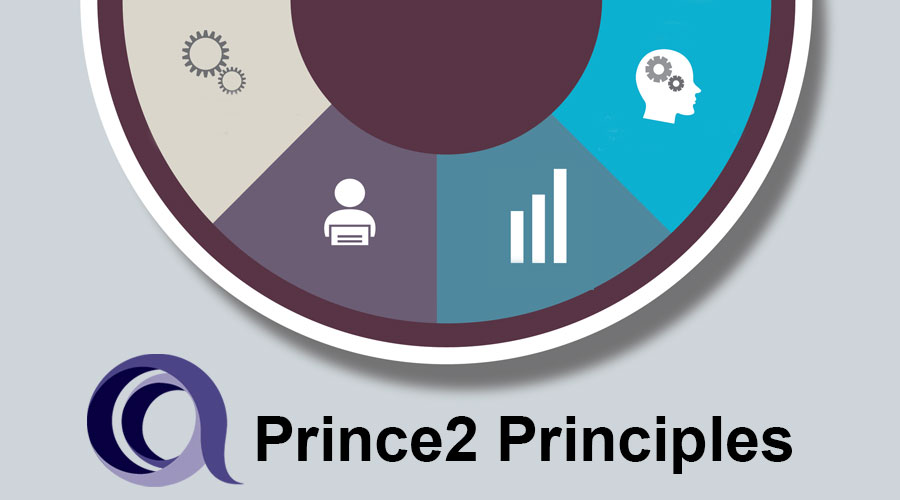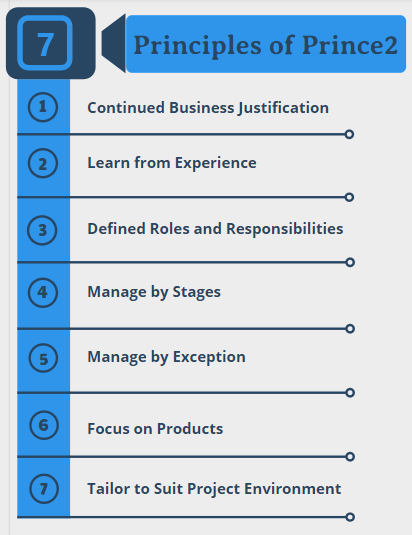
Introduction to Prince2 Principles
Prince2 is a methodology used in structured project management and a kind of practitioner certification program. Prince2 emphasizes breaking down a given project or work into small chunks or workstations for better management and control. Many developed countries like UK, USA, Australia, Germany, France, etc., have already adopted it. The PRINCE2 certification is offered in various languages. The UK developed Prince2 to provide a basic standard for information system management. In this topic, we are going to learn about Prince2 Principles.
Seven Principles of Prince2
There are seven principles based on which Prince2 has been framed, and they cannot be tailored. The Prince2 principle is a kind of mindset that helps the project stay aligned with Prince2.
1. Continued Business Justification
The most important document is the business case, and it is updated whenever required at various stages of the project to make sure it is alive throughout and is relevant. If not done, then the project is destined to die or get terminated. PRINCE2 projects should have a properly defined, evaluated, and well-prepared business case to avoid vague goals, misalignment with the organizational strategy, or duplication with other projects. An organization considers implementing a project to reckon with certain aims. In PRINCE2, projects should be beneficial in some way or the other to the organization. These benefits should be recognized by the entire team dealing with the project. Limitations and restrictions fuel a few projects. Business justification is a must in this case.
2. Learn from Experience
Every project is required to maintain a lesson log referred from time to time when needed and ensure that nothing is re-invented in the concerned project. It is a requirement of PRINCE2 projects to learn from past mistakes and successes.
Learning from experience can take place anytime within the life span of a project:
- In the beginning, during the planning of the project, the experiences and lessons learned from the handling of projects previously come to use very easily. Of course, it takes time to incorporate them, but they cannot be overlooked.
- Throughout the project, the current project lessons can also be included. Continuous assessments are part and parcel of PRINCE2 projects.
- In the end, all the lessons learned should be put into use in all the projects handled in the future. However, a lesson is not said to be learnt if there is no change provoked by it.
3. Defined Roles and Responsibilities
Roles do not define an individual. One individual can take up as many roles as he can, depending on his capability. Corporate or program management, project board, project manager level, and team level are the four roles in Prince2. The last three are relevant to the project management team, where all primary stakeholders, including business, user, and suppliers, are needed to be available. PRINCE2 projects have clearly defined roles and responsibilities.
There are three general categories of project stakeholders:
- Business: The people having any of their business interests in a project are ones included in this category. For example, executives from the parent organization, investors, and the project management team itself.
- Users: The ultimate deliverables of a certain project are used by these stakeholders. The number of users is not a concern. If there is even a slight demand for the final deliverables, then the project needs to be taken.
- Suppliers: These stakeholders are responsible for carrying out the project. It includes everyone. E.g., the project team is also a supplier. People in this category should also be compensated for their work.
4. Manage by Stages
A stage by stage controlling and managing of the project is done. Updating the business case, risks, overall plan, and next stage planning are included in moving stages. PRINCE2 breaks a project into various stages of management. A management stage is very similar to a project phase. Therefore, the entire project and its various aspects should be assessed, and all the pros and cons should be noted. All projects have at least two management stages; the first one deals with project initiation and the second one with project execution.
5. Manage by Exception
To set limits of delegated authority, Prince2 has clearly defined tolerances. If these tolerances are exceeded at a management level, it is referred to as the next management level, and it takes a decision on what to do next.
These tolerance levels must be set for:
- Cost: The budget of a project is the major influence on the implementation of a project. The board should first establish the budget, and then the implementation of the project should start, and in case of any deviation, the upper management needs to be informed.
- Time: A project cannot go on for the longest time possible. There has to be a limit to the time allowed to the project. It is among the foremost things to be established as tolerance, and the project should be completed within that time limit.
- Quality: The quality of the project and its final products and services should be specified before the initiation of the project. These specifications should be met at any cost, and the project has to be planned accordingly.
- Scope: The scope of the project should be established and clearly specified before the initiation of the project. It needs to be strictly adhered to, and any deviation might lead to the failure of the project.
- Benefits: All the projects at the end need to be beneficial for the customers, or else there is no point investing so much time, money, and effort into it. The benefits roped in by the customers help the company earn goodwill and expand its business.
- Risk: Risk is involved no matter what we do in life, and a project is just a part of it. Hence, risk should be managed effectively, or else it would lead to the failure of the project.
6. Focus on Products
The quality of the deliverables until they are timely delivered to the customers is the primary focus of Prince2 projects. Prince2 projects always focus on ultimate products. Therefore, work that contributes towards producing quality products should be the only focus.
7. Tailor to Suit Project Environment
The project environment, size, complexity, importance, time capability, and risk are the parameters based on which Prince2 is designed. The process is then reviewed.
Recommended Articles
This has been a guide to the Prince2 Principles. Here we also discuss the principles of prince2 with their categories and levels. You can also go through our other suggested articles to learn more –

